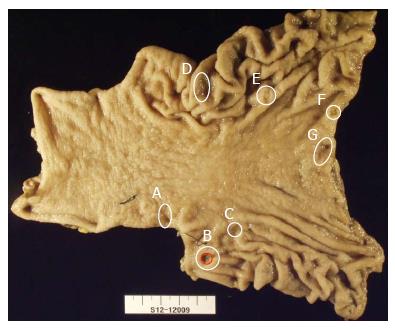Copyright
©2013 Baishideng Publishing Group Co.
World J Gastroenterol. Nov 28, 2013; 19(44): 8141-8145
Published online Nov 28, 2013. doi: 10.3748/wjg.v19.i44.8141
Published online Nov 28, 2013. doi: 10.3748/wjg.v19.i44.8141
Figure 1 Endoscopic and histologic findings.
Multiple early gastric cancer lesions were as follow: A: Raised lesion on the posterior wall of the proximal antrum; B: Erythematous depressive lesion; C: Depressed lesion on the posterior wall of the low body; D: Ill demarcated flat lesion on the anterior wall of the proximal antrum; E, F: Ill demarcated depressed lesion on the anterior wall of the low body (E), on the anterior wall of the mid body (F); G: Ill demarcated flat lesion on the lesser curvature of mid body; H: Adenocarcinoma in lesion B showed invasion into 1/3 of the submucosal layer (arrow) (× 40); I: Lymphatic invasion magnified in quadrangle in H (× 100).
Figure 2 Gross specimen.
Three lesions (D-F) are located on the anterior wall, and the other three lesions (A-C) are on the posterior wall. One lesion (G) shows flat early gastric cancer type IIb configuration and is centered at the body, lesser curvature.
Figure 3 Histopathlogical findings.
A-G: Adenocarcinoma, poorly differentiated in each early gastric cancer lesions in Figure 1 (× 40); H: Lymph node metastasis after gastrectomy (× 40); I: Signet ring cell type of biopsy specimen in esophagogastroduodenoscopy (× 100).
- Citation: Seong H, Kim JI, Lee HJ, Kim HJ, Cho HJ, Kim HK, Cheung DY, Kim DJ, Kim W, Kim TJ. Seven synchronous early gastric cancer with 28 lymph nodes metastasis. World J Gastroenterol 2013; 19(44): 8141-8145
- URL: https://www.wjgnet.com/1007-9327/full/v19/i44/8141.htm
- DOI: https://dx.doi.org/10.3748/wjg.v19.i44.8141











